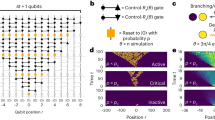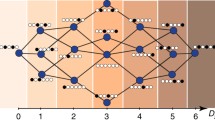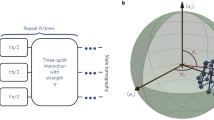We propose a (theoretical) model for quantum computation where the result can be read out from the time average of the Hamiltonian dynamics of a 2-dimensional crystal on a cylinder.The Hamiltonian is a spatially local interaction among Wigner–Seitz cells containing six qubits. The quantum circuit that is simulated is specified by the initialization of program qubits. As in Margolus’ Hamiltonian cellular automaton (implementing classical circuits), a propagating wave in a clock register controls asynchronously the application of the gates. However, in our approach all required initializations are basis states. After a while the synchronizing wave is essentially spread around the whole crystal. The circuit is designed such that the result is available with probability about 1/4 despite of the completely undefined computation step. This model reduces quantum computing to preparing basis states for some qubits, waiting, and measuring in the computational basis. Even though it may be unlikely to find our specific Hamiltonian in real solids, it is possible that also more natural interactions allow ergodic quantum computing.
Similar content being viewed by others
Explore related subjects
Discover the latest articles, news and stories from top researchers in related subjects.References
R. Raussendorf H. Briegel (2000) Phys. Rev. 86 5188
S. Benjamin, Quantum computing with globally controlled exchange-type interactions. quant-ph/0104117
S. Benjamin, Schemes for parallel quantum computation without local control of qubits. quant-ph/9909007
D. Leung, Two-qubit projective measurements are universal for quantum computation. quant-ph/0111122, 2001
D. Aharonov, W. van Dam, J. Kempe, Z. Landau, S. Lloyd and O. Regev. Adiabatic quantum computation is equivalent to standard quantum computation. quant-ph/0405098, 2004.
Benioff P. J. Stat. Phys., 22(5) 1980.
R. Feynman, Opt. News, 11, 1985.
N. Margolus (1986) Ann. NY Acad. Sci. 480 480–497
P. Wocjan, Estimating mixing properties of local Hamiltonian dynamics and continuous quantum random walks is PSPACE-hard. quant-ph/0401184.
A. Kitaev, Quantum measurements and the abelian stabilizer problem. Electronic Colloquium on Computational Complexity, (TR96-003), 1996. see also quant-ph/9511026.
Margolus N. Complexity, Entropy, and the Physics of Information. In: Zurek W. (eds) (Addison Wesley Longman, 1990).
A. Yu. Kitaev, A. H. Shen and M. N. Vyalyi, Classical and Quantum Computation, vol 27 of Graduate Studies in Mathematics. American Mathematical Society, 2002.
M. Biafore, in Proceedings of Workshop on Physics of Comp., IEEE Computer Soc. Press, Los Alamitos, CA, 1994, pp. 63–86.
J. Ziman (1972) Principles of the Theory of Solids Cambridge University Press Cambridge
N. Margolus (1990) Complexity, entropy, and the physics of information W. Zurek (Eds) Santa Fee Institute. Addison Wesley Neading, MA 273–287
T. Gramss, On the speed of quantum computers with finite size clocks. Santa Fe Institute Working Papers, 1995. http://www.santafe.edu/sfi/publications/wpabstract/199510086.
D. Aharonov, A. Ambainis, J. Kempe and U. Vazirani, in Proceedings of ACM Symposium on Theory of Computation (STOC’01), July 2001, pp. 50–59.
P. Diaconis S.S. Gupta (Eds) (1988) Group Representations in Probability and Statistics IMS Lecture Notes - Monograph Series Inst. of Math. Stat. Hawyard CA
Ch. Papadimitriou (1994) Computational Complexity Addison Wesley Reading, MA
P. Wocjan, D. Janzing, Th. Decker and Th. Beth, in Proceedings of the WISICT conference, Cancun 2004. quant-ph/0308011.
C. H. Bennett (1973) IBM J. Res. Develop. 17 525–532
Author information
Authors and Affiliations
Corresponding author
Additional information
PACS:03.67.Lx
Rights and permissions
About this article
Cite this article
Janzing, D., Wocjan, P. Ergodic Quantum Computing. Quantum Inf Process 4, 129–158 (2005). https://doi.org/10.1007/s11128-005-4482-9
Received:
Accepted:
Issue Date:
DOI: https://doi.org/10.1007/s11128-005-4482-9




